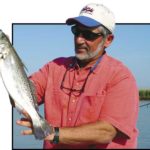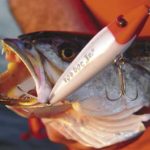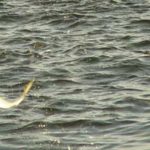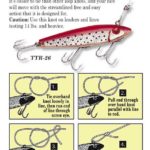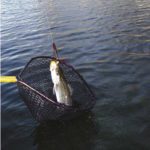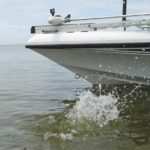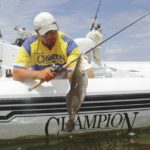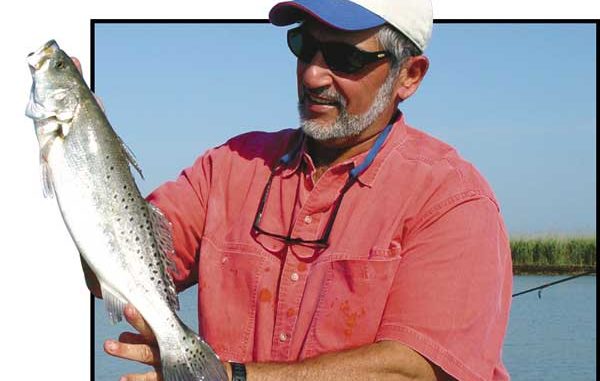
You’ll feel like a king when a trophy trout explodes like a volcano on your topwater plug.
Click, clack, click, clack, click-whoosh! Before the next clack, the red/white Top Dog was mauled by a 4-pound speckled trout.
If you have never experienced the rush of topwater fishing, April is a great month to start.
The winds of March have settled and the mullet and other baitfish begin showing up in large numbers. The brown shrimp are not far behind. Large female trout begin gathering and gorging to prepare their bodies for the approaching spawn.
The month of April provides Southeast Louisiana anglers prime conditions for pursuing speckled trout with topwater lures. Large trout are common, and even full limits may be caught without tying on anything but a topwater plug.
This year, April’s full moon will be on the 20th of the month. The tidal activity associated with the full moon sparks the trout’s spawning activity. Generally, the few days before through the few days after will see the most activity. However, the entire month will provide ample opportunity to target trout on top.
Anglers not using topwater lures during this time are missing out on some fantastic action and, just possibly, the trout of their dreams. Experienced topwater fishermen know that there is no more exciting or productive method for catching trophy-sized trout.
Though topwater fishing doesn’t really require any special equipment, most dedicated topwater anglers will usually set up one outfit that they prefer to use for topwater. While spinning reels will certainly work, baitcasters provide more lure control, pinpoint casting and will not fatigue you as much if you spend the day chunking large topwater plugs.
Line is somewhat of a personal choice. Monofilament in the 15- to 17-pound range is generally considered best. The buoyancy of the mono allows the lure to work better. The natural stretch of the mono also helps to keep the large treble hooks from ripping out of a trout’s soft mouth.
However, many anglers successfully use braid. They like the additional sensitivity braid provides, and a short mono leader will provide the necessary shock absorption.
Topwater lures vary in styles and sizes. Some are designed to chug, pop and splash on the surface. Others are designed particularly to be used for the popular zig-zag retrieve that is commonly called “walking the dog.” The rhythmic movement of these lures combined with the clicking sounds made by the internal rattles is virtually irresistible to hungry trout.
Most topwater lures are armed with two to three large treble hooks. While it is virtually impossible to touch one of these lures without it sticking right through your flesh, trout somehow manage to hit them several times and then swim away unscathed. While it is disappointing to miss a fish, the explosions that occur when a trout strikes on top are certainly an adrenalin rush.
If you are serious about fishing topwater, a rubber, “tangle free” landing net will also prove to be a lifesaver. You’ll spend much less time getting all those trebles out of the net, and the rubber coating will also protect the fish in the event you choose to release it.
Louisiana Sportsman talked to several of the area’s top guides to get their input on topwater fishing in Southeast Louisiana. Chances are you already fish these areas, but if you are not using topwater baits, you are missing out on some serious excitement.
Lake Pontchartrain
Capt. Greg Schlumbrecht’s To Fish guide service specializes in fishing Lake Pontchartrain and the surrounding areas. While the lake itself is known for its large trout around the vast expanse of bridges and areas such as Seabrook, it also offers many good topwater areas.
“Topwaters aren’t very effective around Pontchartrain’s bridges, but the shoreline of the lake near the Tchefuncte River, Bayou Lacombe, Carr Drive and Salt Bayou offers some great topwater action,” said Schlumbrecht.
These areas are all on the north shore of the lake and offer protected topwater fishing in virtually all winds except those from the south.
“The best topwater conditions for fishing Pontchartrain are dead calm to a light chop,” said Schlumbrecht. “If a south wind makes northern shorelines unfishable, there are several areas across the lake near Irish Bayou that will provide topwater action.”
Schlumbrecht searches for shoreline areas that have grass beds or shell bottoms.
“The trout will hold near these areas waiting to ambush the bait coming into the lake,” he said. “Working a topwater bait near these shorelines will provide some great topwater action.”
In Schlumbrecht’s experience fishing Lake Pontchartrain, popping-style topwater plugs don’t seem to work as well as the walk-the-dog style baits. He says beginning topwater anglers can drastically improve their success by doing two simple things.
“Most topwater strikes are missed because the angler overreacts to the excitement of the strike and actually jerks the bait away from the fish before it is hooked,” said Schlumbrecht. “A few tries at working a topwater bait with your eyes closed will allow anglers to develop the proper method of not pulling back until the weight of the fish is actually felt on the line.”
Schlumbrecht also recommends that topwater anglers practice the walk-the-dog retrieve.
“A smooth, rhythmic retrieve will produce more fish than a clumsy, erratic one,” he said. “With a little practice, anyone can learn to work the lure and become a successful topwater fisherman.”
Another note added by Schlumbrecht is that while moving water is always preferred, the tables for predicting tide times and range in Lake Pontchartrain are virtually useless.
“You can throw them in the garbage,” he said. “Tidal activity in the lake is wind-driven and almost impossible to predict. The tide will certainly change, but it may be hours off, and the range may not be as expected.”
But no matter what the tide direction or range, Schlumbrecht knows what he’ll have tied on this month.
“There’s nothing more exciting than a topwater strike,” he said.
Hopedale
Capt. C.T. Williams is co-owner of Big Fish Charters based out of Hopedale. Located at the intersection of Bayou LaLoutre and the Mississippi River Gulf Outlet (MRGO), Hopedale offers easy access to some of the best topwater fishing in Southeast Louisiana.
“Next to slamming them, topwater is my favorite trout-fishing method,” said Williams.
He recommends heavy monofilament and fatter “mullet-shaped” topwater plugs.
“A baitcaster is critical for topwater fishing,” he said. “Spinning gear will work, but a baitcaster will afford much more accuracy, lure control and less casting fatigue.”
Most fishermen know that lures are designed as much to catch fishermen as they are fish. However, this is usually forgotten immediately upon entering a tackle store.
Williams notes that subsurface lures are completely seen by a fish and their entire color pattern can make a difference. With topwater lures, however, only the lower sides and bottom are visible to the fish.
“When selecting a topwater lure, the bottom color is the most important,” Williams said.
An important tip he was given by fellow fishing guide, Capt. Theophile Bourgeois is not to use a chrome-colored lure too early or late in the day.
“The low angle of the sun produces too much reflection,” he said. “Chartreuse, white and bone colors all work well, and you can use chrome later in the day when the sun gets higher.”
Williams prefers working the baits over structure like grass or oyster shells. An often overlooked method he recommends is to throw topwater lures while drifting over oyster beds.
“The beds are marked with PVC poles, and can easily be located in many lakes and bays,” he said.
Williams recommends trying topwater lures at all of the islands and reef areas in Breton Sound.
“Battledore, Iron Banks, Stone, Lonesome and Snake all produce some great topwater action,” he said.
Though many of these areas have been subject to erosion, Williams recommends using GPS numbers to locate old reefs and islands that no longer show above the water’s surface.
Another area that Williams says anglers should not overlook is behind the “long rocks” on the north side of the MRGO.
“This area was extensively pumped in with dredge material from the ship channel,” he said. “The sediment has settled, and there are now grass and oyster beds that attract trout from the surrounding deeper water.”
Other highly recommended areas are the east shoreline of Lake Borgne, the rocks that line both sides of the MRGO and the locks near Violet.
“Anywhere you would think of throwing a live shrimp, try a topwater,” Williams said. “If you’re fishing a cork and the cork gets hit, that’s screaming at you to tie on a topwater.”
Also, look for pods of bait and try a topwater by casting to the edges of the school.
“Don’t cast directly into the bait,” he suggested. “Working a topwater lure around the edges of the school will keep from spooking the bait and the trout that are with them.
“Topwater fishing is absolutely addictive. Throw one on your next fishing trip, and you’ll be hooked.”
Delacroix
“For topwater fishing, I key on islands in the middle of open bays and points and coves that have shells and hard bottom,” said Capt. Stan Cuquet.
Cuquet’s Castaway Charters, which is based in Delacroix Island, has unlimited access to such areas.
“April is a great month for topwater fishing in Delacroix,” he said. “I prefer the days right before the full moon, and the most productive times are early morning or late afternoon.” Cuquet recommends the outer areas such as Oak River Bay, Bay Lafourche and the openings and cuts around Mozambique Point.
He advises anglers to look at old maps to find some great Delacroix-area topwater fishing.
“Maps are normally to find current areas. However, old maps can show you where islands and land used to be,” Cuquet said. “Though not visible above the water, the remaining underwater structure is prime area to fish topwater baits.”
Cuquet notes that most topwater fishermen, even experienced ones, don’t fish topwater anywhere but shallow water.
“Throw a topwater around the structure of a wellhead, and you’ll be amazed at the trout you’ll catch,” he said.
His personal preference is to use 8/30 Power Pro braid with a short length of 20- to 25-pound mono leader and a 7-foot Okuma Guide Select rod.
Top Dogs, Zara Spooks and Skitter Walks top his list of favorite floating plugs.
Cuquet says that a “team approach” can be deadly when fishing topwater for speckled trout. Having one angler throwing a suspending bait such as a Catch 5 or Catch 2000 can really increase the action.
“Having the second angler follow a topwater hook-up or missed strike with a suspending lure will generally produce a fish,” he said.
Like other topwater fishermen, Cuquet knows there is no other method that is more exciting.
“You will always remember your first topwater fish,” he said.
Topwater fishing from a boat is very exciting. However, Cuquet says another dimension can be added to multiply the thrills.
“I run topwater charters to wade fish the barrier islands,” he said.
The islands in the Breton and Chandeleur chains provide anglers with acres of hard, sandy shoreline that is perfect for attracting trout and is easily accessible for wade fishing.
“Standing in waist-deep water and having a large trout explode on your topwater plug is almost indescribable,” he said.
Venice
Capt. Brandon Carter is the owner of Reel Shot Guide Service, and specializes in the Venice area. Carter knows that April will provide anglers with some great topwater action in many areas on the east side of the Mississippi River.
Venice is a large expanse of nearly unlimited canals and bays. In order to narrow down prime areas for topwater action, Carter searches for moving water and schools of small to medium mullet.
“The trout will generally be with the smaller mullet, and the larger mullet will usually attract reds and jacks,” he said.
Carter notes that in many years, the area around Redfish Bay will be the first to turn on for great topwater action.
“Also, when the water is good, Garden Island Bay offers lots of submerged cane that provides excellent topwater action for speckled trout,” he said.
Some of his other favorite topwater areas are Customhouse Bay and Blind Bay.
“Structure plays a very important role in topwater fishing,” said Carter.
Many areas in Venice sustained severe damage and change due to Hurricane Katrina. Carter particularly targets areas with remaining underwater stubble.
“Fish where points and islands used to be. The structure that remains below the surface holds the fish in those areas,” he said.
Most fishermen are aware of the “bigger bait, bigger fish” theory. Carter doesn’t dispute that theory, but believes that using smaller topwater plugs will result in more caught fish.
“Smaller plugs, like the Top Dog Jr. and the She Dog, allow for more hooks to get in a trout’s mouth,” he said. “The bigger plugs also have more weight that allows the trout leverage to shake the hooks out.”
When retrieving topwater lures, Carter recommends a “slow and steady pace.” Even when a fish strikes and misses, Carter says it is best to simply keep the bait moving with the same cadence.
“It takes nerves of steel, but if you don’t react, the fish seem to get mad and will come back and slam the bait again,” he said.
When a fish strikes, Carter says to follow through with your retrieve until you feel the weight of the fish.
“Setting the hook is neither safe nor effective,” he said. “An attempted hook-set can result in a treble hook missile coming flying back at the boat.”
Cater says the best method to anchor a topwater into a trout is to simply sweep the rod once the fish’s weight is felt following a strike.
Carter recommends that anglers try topwater lures almost anywhere they fish.
“Most fishermen associate topwater fishing with very shallow water,” he said.
However, topwater plugs can be effective in most places that speckled trout are sought.
“I never fish a wellhead without at least one person throwing a topwater,” he said. “While the water may be 15-20 feet deep, the trout may be holding nearer the surface and will hit a topwater lure.”
When Carter gets clients who are not as concerned about how many fish they catch, but are more interested in the fishing “experience,” he takes them topwater fishing.
“Topwater fishing offers anglers the chance to see and feel the strike. There is nothing more exciting,” he said.
If you don’t own any topwater lures, now is the time to get some. If you own some and don’t use them, now is the time to tie one on. Once you experience the thrill of topwater fishing, you, and many more trout, will be hooked.
